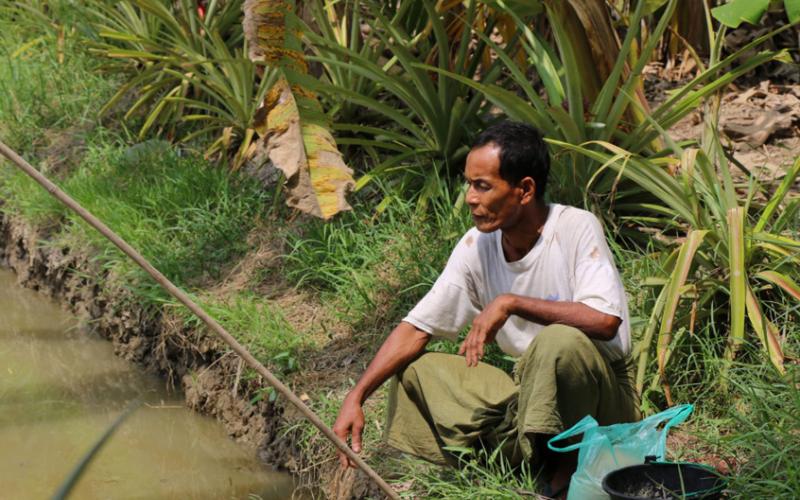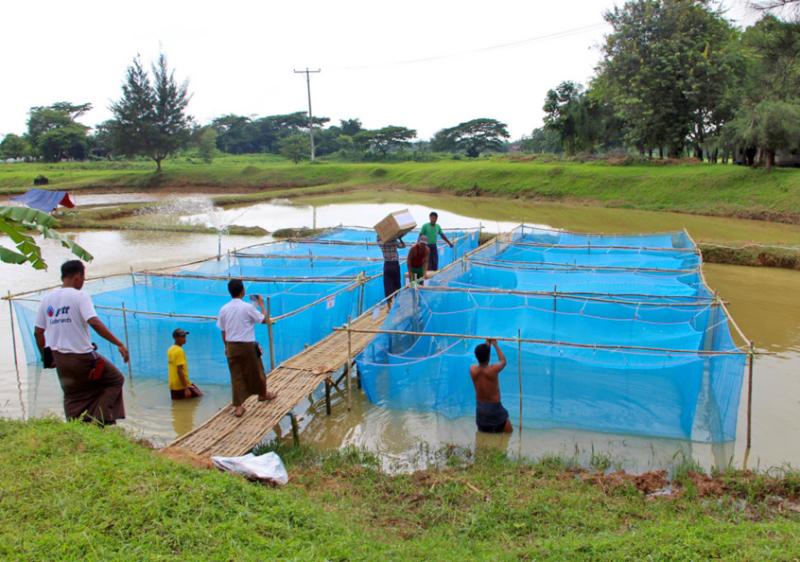
With support from ACIAR, the Government of Myanmar is improving its understanding of local communities and promoting fish-farming technologies adapted to smallholders.
Recommended publications
- Potential for transformation
- Myanmar fisheries: Aquaculture
With support from ACIAR, the Government of Myanmar is improving its understanding of local communities and promoting fish-farming technologies adapted to smallholders
“Fish plays a predominant role in the diet of the people of Burma.” This quote, from the book Fisheries in Burma written in 1948 by U Khin, still has resonance. Fish is second only to rice in terms of food expenditure nationwide. And with an overall production estimated at 5.31 million tonnes, Myanmar is in the top 10 global fish-producing nations.
Historically, fish have been sourced from the wide network of rivers and flood plains and there is a strong preference by local Myanmar consumers for freshwater (mostly carp) species. But the country’s natural water bodies have suffered immensely from the combined effect of economic and demographic growth. There is growing evidence of a rapid reduction in the catch. Following a global trend, aquaculture, the farming of aquatic organisms, is growing faster and is now playing a significant role in supplying fish for local consumers.
Aquaculture operations in Myanmar are dominated by large farms located around Yangon. Compared with other countries in the region, there appears to be a very limited adoption of this promising and potentially lucrative business by smallholders. Concurrently, smallholder farmers from the Ayeyarwady Delta—once called the ‘rice bowl’ of Asia—have suffered from the decades of political turmoil and now have one of the lowest levels of land productivity in the region.
This situation led Dr Nilar Shein and her team from the Department of Fisheries (DoF) to two key questions: To what extent are communities of the Ayeyarwady Delta practising fish farming? How can we ensure they, too, can claim their share of the so-called ‘blue revolution’? Dr Shein and her team have been exploring these questions with the financial support of ACIAR and the technical assistance of WorldFish under the MYFish project.
Identifying and understanding smallholder farmers
“When our project started in 2012, it was very difficult to approach the subject of small-scale aquaculture in the Ayeyarwady Delta because of the scarcity of data, even for DoF,” Dr Shein says. “Fish ponds smaller than 120 square metres are not taxed and, as a consequence, they are not accounted for in the government database.”
Dr Jharendu Pant from WorldFish supported the project team in designing a survey to address these data gaps. The process involved extensive consultation with central and regional government offices, non-government organisations and local village leaders. “After Cyclone Nargis devastated a large portion of the Ayeyarwady Delta in 2008, small-scale aquaculture started to be promoted by various organisations as a livelihood-diversification option,” Dr Pant says. “Unfortunately most of these experiences have remained undocumented and there is very little evidence of what worked and what did not. Our study had to start by a comprehensive review of these experiences.”
These preliminary discussions identified smallscale fish farmers throughout the Ayeyarwady Delta and allowed the team to design a tailored questionnaire to help understand the major challenges and opportunities small-scale fish farmers face. A representative sample of 136 households was interviewed with questions covering demographics, livelihoods, production, and legal and social aspects. The interviews were facilitated by trained officers from DoF under the technical supervision of WorldFish and were complemented by group discussions in most of the villages visited.
Dr Shein says: “It was the first exercise of this kind for most of my colleagues from DoF. The survey ended up being very valuable as it helped us to identify some key challenges and encouraged us to consider new approaches to support the development of the aquaculture sector.”
Overall, the contribution of fish farming to household food production, nutrition security and income generation was found to be significant. Nevertheless, the study indicated the productivity of small-scale fish farms was extremely low.
This makes the adoption of this business unattractive. The lack of technical support and the unfavourable policy environment were identified as additional factors stalling adoption. Yet the interpretation of the results indicated a great potential for expansion, intensification and commercialisation of the aquaculture sector in the Ayeyarwady Delta.

Promoting tailored technologies
“Probably one of the most encouraging outcomes from our survey was the realisation that productivity of these small farms could be significantly improved with very limited technical improvements,” Dr Pant says. “In fact, very often small-scale producers were trying to rely on technologies that did not suit their technical and financial capacity. They had no information on alternative low-cost options.”
Largely inspired by small-scale fish farming practices in the region and carefully building on prevailing technologies encountered in the Ayeyarwady Delta, DoF and WorldFish spent the following three years developing, testing and piloting a wide range of low-cost technologies. This started with the selection and breeding of new indigenous species in three different government fish hatcheries. The team relied on successive cycles of on-station experiments, from which successful technologies were then piloted directly with communities through farmer fieldschool approaches.
Overall more than eight different technologies—ranging from carp polyculture to eel farming and rice–fish farming—were tested by 300 households. Among the beneficiaries, U Win Zaw Ko from Mawbisu village in Dedaye township, recounts: “I only have 100 square metres that I used to stock with a mix of available species without considering their compatibility. Through the project, it was explained that some species can perform well together while others cannot. We did not have access to these recommendations before. The MYFish project also helped me to provide day-to-day extension services by training and mentoring one of my neighbours as a communitybased facilitator.”
The hundreds of farmers involved with MYFish have seen an average productivity increase from 10–40%, but the impact goes beyond the project. Modalities and technologies developed under MYFish have been recently replicated through other development interventions in Myanmar, notably the MYCulture project that aims to scale these technologies to 10,000 households by 2019 and boost incomes, food and nutrition to 40,000 people.
This article first appeared in the ACIAR Partners’ magazine and is republished here with the author’s permission.